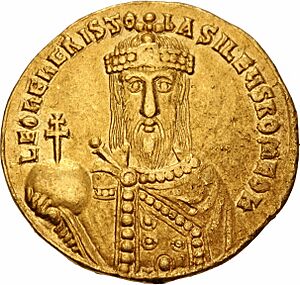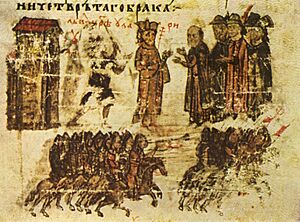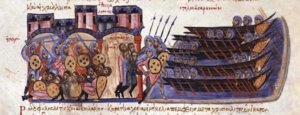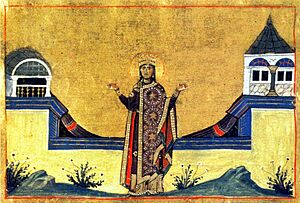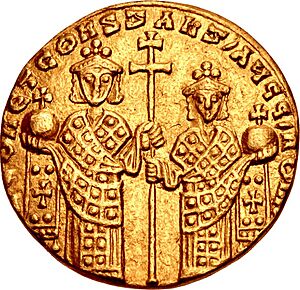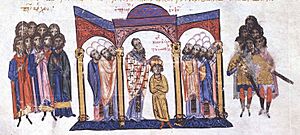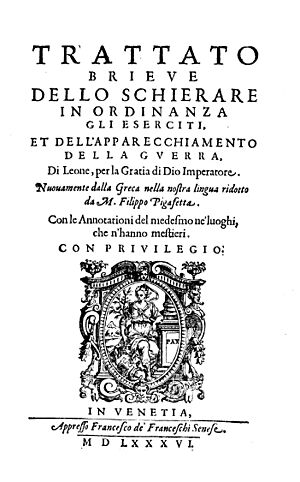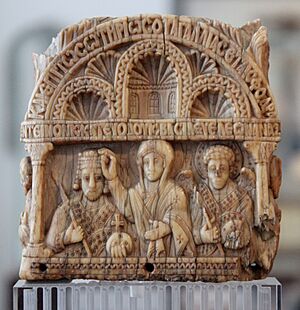Leo VI the Wise facts for kids
Quick facts for kids Leo VI |
|||||
|---|---|---|---|---|---|
| Emperor of the Romans | |||||
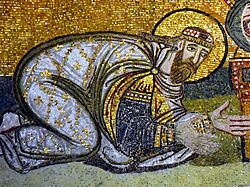
A mosaic in Hagia Sophia showing Leo VI paying homage to Christ
|
|||||
| Byzantine emperor | |||||
| Reign | 29 August 886 – 11 May 912 | ||||
| Coronation | 6 January 870 | ||||
| Predecessor | Basil I | ||||
| Successor | Alexander | ||||
| Born | 19 September 866 Constantinople |
||||
| Died | 11 May 912 (aged 45) Constantinople |
||||
| Burial | Church of the Holy Apostles, Constantinople | ||||
| Wives |
|
||||
| Issue | by Theophano Eudokia by Zoe Zaoutzaina Anna by Eudokia Basil by Zoe Karbonopsina Anna Constantine VII |
||||
|
|||||
| Dynasty | Macedonian | ||||
| Father |
|
||||
| Mother | Eudokia Ingerina | ||||
| Religion | Greek Orthodox | ||||
Leo VI, also known as Leo the Wise, was a Byzantine Emperor who ruled from 886 to 912. He was the second emperor from the Macedonian dynasty, though there were questions about who his real father was. Leo was known for being very smart and well-read, which is why people called him "the Wise."
During his time as emperor, learning and culture continued to grow, a trend that began with the previous emperor, Basil I. However, the Byzantine Empire also faced some tough military defeats. They lost battles in the Balkans against Bulgaria and against Arab forces in Sicily and the Aegean Sea. His reign also saw the official end of some very old Roman traditions, like the separate job of Roman consul.
Contents
Early Life of Leo VI
Leo was born on September 19, 866. His mother was Empress Eudokia Ingerina. It was unclear if his father was Emperor Michael III or Michael's successor, Basil I. Eudokia was both Michael III's close companion and Basil's wife.
In 867, Basil arranged for Michael to be killed and then became emperor himself. As Basil's second oldest son, Leo was made a co-emperor in 870. He became the direct heir when his older half-brother, Constantine, died in 879.
However, Leo and Basil did not get along well. Their relationship got worse after Eudokia died. Leo was not happy with his marriage to Theophano Martinakia. He then became close with Zoe Zaoutzaina. Basil arranged for Zoe to marry another official. Later, Basil almost had Leo blinded because he was accused of planning against him. On August 29, 886, Basil died in a hunting accident. On his deathbed, he claimed someone tried to kill him and that Leo might have been involved.
Leo VI's Rule: Domestic Policy
One of the first things Leo VI did after becoming emperor was to rebury the remains of Michael III. He did this with a grand ceremony in the imperial tomb at the Church of the Holy Apostles in Constantinople. This made people suspect that Leo believed he was truly Michael's son.
To bring peace to the empire, the new emperor gained the support of officials in the capital city. He surrounded himself with important government workers, like Stylianos Zaoutzes (who was the father of his close companion, Zoe Zaoutzaina) and the eunuch Samonas. Samonas was an Arab who had joined the Byzantine side. Leo promoted him to a high rank and Samonas became the godfather to Leo's son, Constantine VII.
Leo tried to control the powerful noble families, such as the Phokadai and the Doukai. This sometimes led to serious disagreements. The most important one was the revolt led by Andronikos Doukas in 906.
Leo also tried to get involved in church matters by changing who was in charge of the church. He used the fact that his former teacher, Patriarch Photios, had been removed by the Pope as an excuse. Leo dismissed Photios and replaced him with his own 19-year-old brother, Stephen, in December 886. When Stephen died in 893, Leo replaced him with a person chosen by Zaoutzes, Antony II Kauleas, who died in 901.
Leo then promoted his own secretary, Nicholas. However, Nicholas was suspected of being involved in a failed attempt to harm Leo in 903. He also disagreed with Leo's fourth marriage. So, Nicholas was replaced with Leo's spiritual advisor, Euthymios, in 907.
The beautiful Church of Agios Lazaros in Larnaca was built during Leo VI's rule in the late 9th century. It was constructed after the holy items of St. Lazaros were moved from Crete to Constantinople. This church is a great example of Byzantine architecture.
Leo also finished work on the Basilika. This was a Greek translation and update of the law code created by Justinian I. This important legal work had been started during Basil's reign.
A bishop named Liutprand of Cremona wrote stories about Leo. He said that Leo would sometimes dress up and walk around Constantinople to find unfairness or corruption. In one story, city guards even arrested him during one of his investigations. He was walking alone and disguised late at night. He gave money to two patrols, but a third patrol arrested him. The next morning, a terrified guard recognized the emperor in jail. The officer who arrested him was rewarded for doing his job, while the other patrols were fired and punished.
Leo VI's Rule: Foreign Policy
Leo VI had mixed results in his wars, not as successful as Basil had been. By favoring his main advisor, Stylianos Zaoutzes, Leo started a war with Simeon I of Bulgaria in 894, but he was defeated. Leo then paid the Magyars to attack the Bulgarians from the north, which helped him indirectly in 895.
However, without his new allies, he lost the important Battle of Boulgarophygon in 896. He then had to agree to trade deals and pay a yearly tribute to Bulgaria.
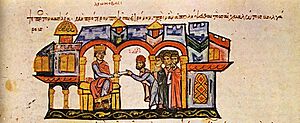
Although he won a victory in 900 against the Emirate of Tarsus, where the Arab army was destroyed and their leader captured, in the west, the Emirate of Sicily took Taormina. This was the last Byzantine stronghold on the island of Sicily in 902.
Despite this, Leo kept putting pressure on his eastern border. He created a new military district called Mesopotamia. There was also a Byzantine invasion of Armenia in 902 and the capture of Theodosiopolis. Successful raids also happened in the Arab border areas.
Then, in 904, the rebel Leo of Tripolis and his pirates attacked and robbed Thessalonica. This event is described in a book called The Capture of Thessalonica. Also, a large effort to take back Crete led by Himerios in 911–912 failed badly.
However, during the same time, important border areas called kleisourai were set up. These were Lykandos and Leontokome, on land recently taken from the Arabs. In 907, Constantinople was attacked by the Kievan Rus' under Oleg of Novgorod. Oleg wanted better trading rights with the empire. Leo paid them off, but they attacked again in 911. Finally, a trade agreement was signed.

Leo VI's Marriages and Family
Leo VI caused a big stir with his many marriages. He struggled to have a son who could legally inherit the throne. His first wife, Theophano Martinakia, died in 897. Leo had been forced to marry her by Basil because of her family connections, and Leo did not like her.
Leo then married Zoe Zaoutzaina, the daughter of his advisor Stylianos Zaoutzes. She also died in 899. After this marriage, Leo created a special title, basileopatōr ("father of the emperor"), for his father-in-law.
After Zoe's death, a third marriage was technically against the rules. But he married again, only to have his third wife, Eudokia Baïana, die in 901. Instead of marrying a fourth time, which would have been an even bigger problem than a third marriage (according to the Patriarch Nicholas Mystikos), Leo became close with Zoe Karbonopsina. He only married her after she gave birth to a son, Constantine VII, in 905. This marriage caused strong opposition from the patriarch.
Leo replaced Nicholas Mystikos with Euthymios. Leo's marriage was then recognized by the church, but he had to do a long period of penance. He also had to promise that he would make all future fourth marriages illegal.
Succession to the Throne
The future Constantine VII was born before Leo's fourth marriage to Zoe Karbonopsina. To make sure his son would become emperor, Leo had Constantine crowned as co-emperor on May 15, 908, when he was only two years old.
Leo VI died on May 11, 912. His younger brother, Alexander, became emperor after him. Alexander had been ruling alongside his father and brother since 879.
Alexander died thirteen months later, and Constantine became the sole emperor. Shortly before Constantine became an adult, one of his regents made himself a senior co-emperor. This was Romanos I. Romanus married his daughter to Constantine. Their son became emperor as Romanos II when Constantine died in 959.
Leo VI's Writings and Laws
Leo VI was a very active writer. He created works on many different subjects and in various styles. These included speeches about politics, religious poems, and writings about theology. He often personally gave very detailed and complex sermons in the churches of Constantinople.
In the area of law, he set up a group to carry out his father's plan to organize all existing Byzantine laws. The final result was a six-volume work with 60 books, called the Basilika. Written in Greek, the Basilika translated and neatly arranged almost all the laws from the Corpus Juris Civilis. This provided a strong base for all later Byzantine laws.
Leo then started adding new laws from his own reign into the Basilika. These were called "Novels," or "New Laws." They dealt with current problems and issues, such as making fourth marriages illegal. Both the Basilika and the Novels included church laws (canon law) as well as regular laws.
Most importantly, from a historical point of view, these laws finally removed many of the old legal structures that the Byzantine Empire had inherited from the Roman Empire. Old institutions like the Curiae, the Roman Senate, and even the Consulate were officially removed from a legal standpoint. However, some of these still continued in a smaller, symbolic way.
The supposed Book of the Prefect and the Kletorologion of Philotheos were also released under Leo's name. These show his government's interest in organizing things and keeping public order. The Book of the Eparch described the rules for trade and trade groups in Constantinople. The Kletorologion tried to standardize officials and ranks at the Byzantine court. Leo is also the author, or at least supported the creation of, the Tactica. This is an important book about military operations.
Later generations saw Leo as a prophet and a magician. Soon, a collection of poems that seemed to predict the future and some short texts about telling the future were linked to the Emperor's name. These were called the Oracles of Leo the Wise. They were partly based on older Greek writings and were believed to foretell the future of the world.
Finally, Leo is given credit for moving the holy items of St. Lazarus to Constantinople in 890. There are several hymns attributed to him that are sung on Lazarus Saturday in the Eastern Orthodox Church. He also wrote hymns that are sung on the Great Feast of the Exaltation of the Cross.
Leo VI's Family
Leo VI had children with his four wives:
- By his first wife, Theophano Martinakia, Leo VI had one daughter:
- Eudokia, who passed away in 892.
- By his second wife, Zoe Zaoutzaina, Leo had one daughter:
- Anna, who was engaged and married to the Holy Roman Emperor Louis the Blind.
- By his third wife, Eudokia Baïana, Leo had one son:
- Basil, who lived for only a few days.
- By his fourth wife, Zoe Karbonopsina, Leo had two children:
- Anna
- Constantine VII.
See also
 In Spanish: León VI el Sabio para niños
In Spanish: León VI el Sabio para niños



